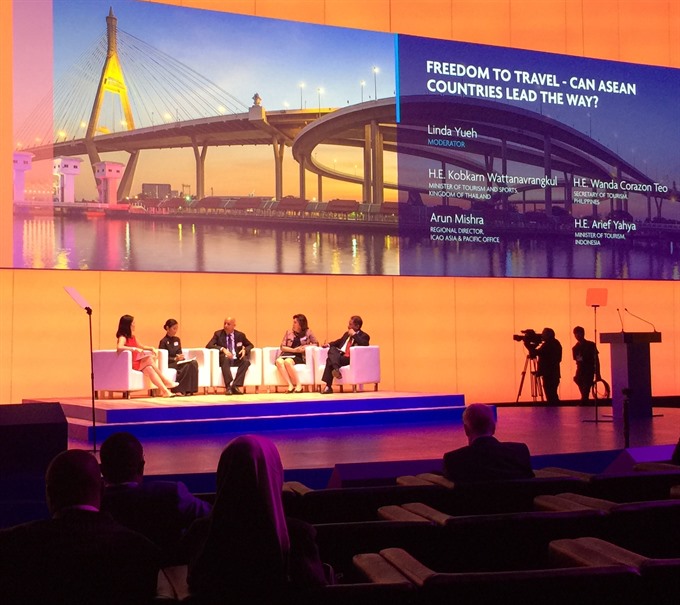 Life & Style
Life & Style

ASEAN countries have the potential to become one of the world’s most attractive destinations for travel and tourism, a panel of speakers consisting of high level officials from Thailand, Indonesia and the Philippines said at the World Travel and Tourism Summit 2017 Global Summit in Bangkok, Thailand.
 |
| ASEAN tourism ministers discuss future of the region on global tourism map at the 2017 WTTC Global Summit. — VNS Photo Hoang Anh |
BANGKOK — ASEAN countries have the potential to become one of the world’s most attractive destinations for travel and tourism, a panel of speakers consisting of high level officials from Thailand, Indonesia and the Philippines said at the World Travel and Tourism Summit 2017 Global Summit today in Bangkok, Thailand.
The panel, including Minister of Tourism of Thailand Kobkarn Wattanavrangkul, Minister of Tourism of Indonesia Arief Yahya, Secretary of Tourism of the Philippines Wanda Teo and Regional Director of the Asia and Pacific Office International Civil Aviation Organisation (ICAO) Arun Mishra, discussed the future of the region as an integrated single destination on the global travel and tourism map.
ASEAN, which was formed in 1967, has expanded its membership to 10 countries in the South East Asia region -- Brunei, Cambodia, Indonesia and Laos, as well as Malaysia, Myanmar, the Philippines and Singapore, along with Thailand and Viet Nam. The bloc, with total population of 629 million, is currently one of the world’s fastest growing economies following the formation of the ASEAN Economic Community (AEC) in 2015 with a combined GDP that is projected to catch up to the European Union’s in 2030, according to a research published by the Asian Development Bank Institute last year.
The region’s travel and tourism industry is to play a huge part in the realisation of that projection, said Wattanavrangkul, who urged ASEAN countries to speed up on the region’s connectivity through numerous methods of transportation -- air highways, sea and rivers.
Consistent and high economic growth among ASEAN countries in recent years as well as visa-free travel have seen a surge in the number of intra-ASEAN tourists, which is to remain one of the bloc’s key priorities in the years to come.
ASEAN member countries’ tourism authorities place great importance on the process to streamline visa application and facilitate ease of travel for visitors to the region. Work has started on the ambitious single visa entry project for ASEAN countries as well as the establishment of ASEAN’s land-based north-south corridor, which will connect all ASEAN countries from the south of China all the way down to Malaysia, the east-west corridor that begins in India and goes all the way to Viet Nam.
The Thai minister said ASEAN countries are connected in many ways. Visitors can choose to travel either by land, by sea, by air and even by the Mekong River, which runs through Cambodia, Laos, Myanmar, Thailand and Viet Nam.
Despite the vast tourism potential, the region also faces numerous daunting challenges, especially in developing infrastructure and human resources, both key factors for a robust tourism industry. The ministers urged the private sector to cooperate with governments to invest in airports, seaports and other networks of transportation.
Mishra from the ICAO said ASEAN countries must invest more in training high skilled workers, especially in the field of aviation technology to help with the region’s already-congested air traffic.
Indonesian tourism minister Yahya called on ASEAN governments to bring out greater harmonisation of regulations that will allow member countries to better address their shortage of labour in specific fields with a freer flow of high skilled workers.
Answering question regarding whether individual countries should prioritize promoting their own destinations or the whole region as one single destination, Yahya said the bloc’s shared vision is to develop ASEAN as one single destination with each member ultilising their competitive advantages to form a united front in competition with Asia’s larger competitors such as China and India. — VNS




